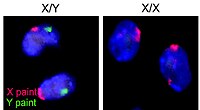| Part of a series on |
| Sex |
|---|
 |
| Biological terms |
| Sexual reproduction |
| Sexuality |
| Sexual system |
Temperature-dependent sex determination (TSD) is a type of environmental sex determination in which the temperatures experienced during embryonic/larval development determine the sex of the offspring.[1] It is observed in reptiles and teleost fish, with some reports of it occurring in species of shrimp.[2][3][4][5][6] TSD differs from the chromosomal sex-determination systems common among vertebrates. It is the most studied type of environmental sex determination (ESD). Some other conditions, e.g. density, pH, and environmental background color, are also observed to alter sex ratio, which could be classified either as temperature-dependent sex determination or temperature-dependent sex differentiation, depending on the involved mechanisms.[7] As sex-determining mechanisms, TSD and genetic sex determination (GSD) should be considered in an equivalent manner,[8] which can lead to reconsidering the status of fish species that are claimed to have TSD when submitted to extreme temperatures instead of the temperature experienced during development in the wild, since changes in sex ratio with temperature variation are ecologically and evolutionally relevant.[7]
While TSD has been observed in many reptile and fish species, the genetic differences between sexes and molecular mechanisms of TSD have not been determined.[7] The cortisol-mediated pathway and epigenetic regulatory pathway are thought to be the potential mechanisms involved in TSD.[7][9]
The eggs are affected by the temperature at which they are incubated during the middle third of embryonic development.[10] This critical period of incubation is known as the thermosensitive period.[11] The specific time of sex-commitment is known due to several authors resolving histological chronology of sex differentiation in the gonads of turtles with TSD.[10]
- ^ Ido Pen; Tobias Uller; Barbara Feldmeyer; Anna Harts; Geoffrey M. While & Erik Wapstra (2010). "Climate-driven population divergence in sex-determining systems". Nature. 468 (7322): 436–439. Bibcode:2010Natur.468..436P. doi:10.1038/nature09512. PMID 20981009. S2CID 4371467.
- ^ Warner DA, Shine R (2008). "The adaptive significance of temperature-dependent sex determination in a reptile". Nature. 451 (7178): 566–568. Bibcode:2008Natur.451..566W. doi:10.1038/nature06519. PMID 18204437. S2CID 967516.
- ^ Bachtrog, Doris; Mank, Judith E.; Peichel, Catherine L.; Kirkpatrick, Mark; Otto, Sarah P.; Ashman, Tia-Lynn; Hahn, Matthew W.; Kitano, Jun; Mayrose, Itay (2014-07-01). "Sex determination: why so many ways of doing it?". PLOS Biology. 12 (7): e1001899. doi:10.1371/journal.pbio.1001899. ISSN 1545-7885. PMC 4077654. PMID 24983465.
- ^ Tree of Sex Consortium (2014-01-01). "Tree of Sex: a database of sexual systems". Scientific Data. 1: 140015. doi:10.1038/sdata.2014.15. PMC 4322564. PMID 25977773.
- ^ Ospina-Alvarez, Natalia; Piferrer, Francesc (2008-07-30). "Temperature-dependent sex determination in fish revisited: prevalence, a single sex ratio response pattern, and possible effects of climate change". PLOS ONE. 3 (7): e2837. Bibcode:2008PLoSO...3.2837O. doi:10.1371/journal.pone.0002837. ISSN 1932-6203. PMC 2481392. PMID 18665231.
- ^ Serezeli, Ramazan (December 2017). "To what extent does temperature affect sex ratio in red cherry shrimp, neocaridina davidi? The scenario global warming to offspring sex ratio". Research Gate. Retrieved 26 October 2023.
- ^ a b c d Shen, Zhi-Gang; Wang, Han-Ping (2014-04-15). "Molecular players involved in temperature-dependent sex determination and sex differentiation in Teleost fish". Genetics Selection Evolution. 46 (1): 26. doi:10.1186/1297-9686-46-26. ISSN 1297-9686. PMC 4108122. PMID 24735220.
- ^ Grossen, Christine; Neuenschwander, Samuel; Perrin, Nicolas (2011-01-01). "Temperature-dependent turnovers in sex-determination mechanisms: a quantitative model". Evolution; International Journal of Organic Evolution. 65 (1): 64–78. doi:10.1111/j.1558-5646.2010.01098.x. ISSN 1558-5646. PMID 20722730. S2CID 19290433.
- ^ Piferrer, Francesc (2013-04-01). "Epigenetics of sex determination and gonadogenesis". Developmental Dynamics. 242 (4): 360–370. doi:10.1002/dvdy.23924. ISSN 1097-0177. PMID 23335256.
- ^ a b Wibbels, T.; Bull, J.J.; Crews, D. (1991). "Chronology and morphology of temperature dependent sex determination". The Journal of Experimental Zoology. 260 (3): 371–381. doi:10.1002/jez.1402600311. PMID 1744617.
- ^ Delmas, V.; Prevot-Julliard, A.-C.; Pieau, C.; Girondot, M. (2008). "A mechanistic model of temperature-dependent sex determination in a chelonian: the European pond turtle". Functional Ecology. 22: 84–93. doi:10.1111/j.1365-2435.2007.01349.x. S2CID 22610200.